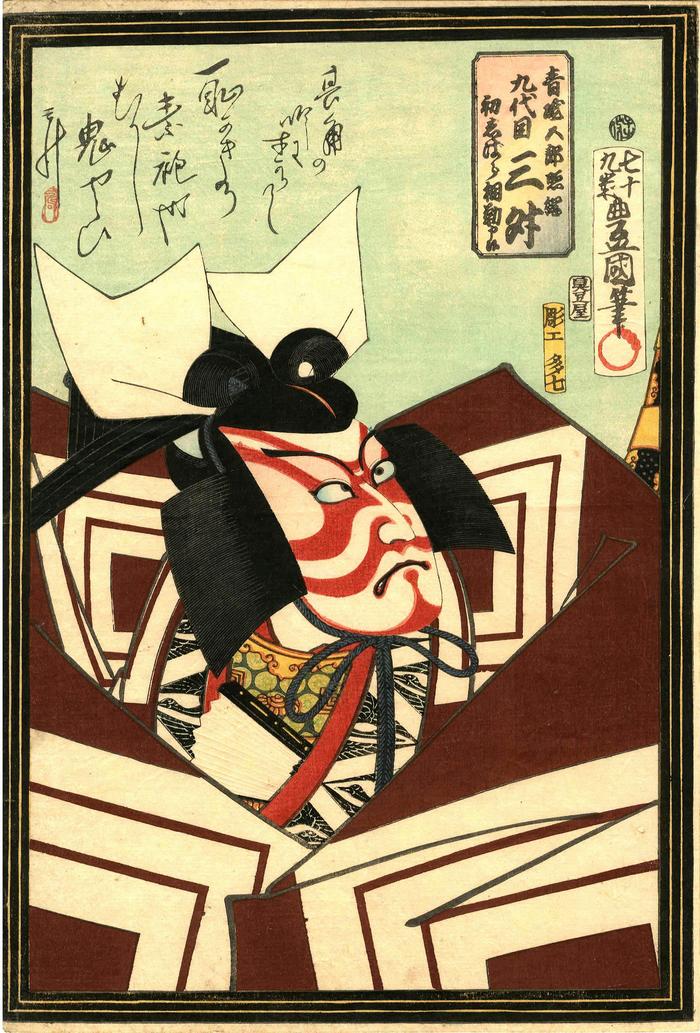Utagawa Kunisada (歌川国貞) / Toyokuni III (三代豊国) (artist 1786 – 01/12/1865)
Kudaime Mimasu IX (九代目三升) as Aoto Gorō Terutsuna (青砥五郎照綱) in his first performance of Shibaraku
11/03/1864
9.5 in x 14 in (Overall dimensions) Japanese woodblock print
Signed: Nanajūkyūsai Toyokuni hitsu
七十九歳豊国筆
From the brush of 79 year old Toyokuni
Artist seal: toshidama
Publisher: Gusokuya Kahei
Carver: Horikō Tashichi
彫工多七
Date/censor seal: 11/1864 and aratame
Museum of Fine Arts, Boston
Ritsumeikan University
Waseda University
Tokyo Metropolitan Library
Shizuoka Prefectural Library
Hankyu Culture Foundation
Ackland Museum of Art, University of North Carolina
British Museum - donated by Dr. Ellis Tinios Mimasu IX also performed under the name Kawarasaki Gonjūrō I (河原崎権十郎) and later as Ichikawa Danjūrō IX. The " ‘Shibaraku’ scene from Act I of the play ‘Chijinyu mitsugumi sakazuki’ [三達徳組公爵]; performed at the Nakamura-za in the 11th month of 1864. (Genji 1)."
The cartouche reads: 九代目三升 青砥五郎照綱 初しばらく相勤申候. The transliteration is: "Kudaime Sansho Aoto Goro Terutsuna Hatsu Shibaraku aitsutome moshisoro", while the translation is Sansho IX, playing the role of Aoto Goro Terutsuna in his first ‘Shibaraku’ Inscription note: actor, role and scene name." (Source: the British Museum)
****
The importance of Shibaraku!
In 1994 Timothy Clark wrote in The Actor's Image: Print Makers of the Katsukawa School, on page 138: "The "Shibaraku" scene is the ultimate confrontation between good and evil in Kabuki, and the most perfect display of the bombastic, stylized aragoto (tough stuff) acting style associated with the Ichikawa Danjūrō line of actors. First performed by Danjūrō I in 1697, it became obligatory from the early eighteenth century to include the scene in the opening-of-the-season (kaomise) productions held at every theater in the eleventh month of each year."
****
"A scene of roughly 50 minutes, Shibaraku is not a play unto itself, but a short drama inserted during interludes or in between full plays to provide variety and maintain a certain level of energy and interest on the part of the audience."
The plot centers around the figure of Kamakura Gongorō Kagemasa, who has become the stereotypical bombastic hero of the kabuki stage, with red-and-white striped makeup and strong, energetic movement. The historical Kamakura Kagemasa is famous for his bravery for having continued to fight after losing an eye in battle in the Gosannen War (1083-1087). The climactic moment of this short work takes place when a goodly samurai is being assaulted by a number of villains. Kagemasa "...shouts "Shibaraku!" (Stop a moment!) loudly from behind a curtain (agemaku) and then steps out onto the hanamichi (a raised platform extending through the audience to the stage) in magnificent costume and makeup. Arriving at the stage, he sits on a stool (aibiki) and, in a special kind of monologue called tsurane, explains his story." He then drives the villains off and, as the curtain falls, greets the audience from the hanamichi, not as the hero, but as the actor. The work is derived from an actual occurrence involving Danjūrō I. On this particular occasion, when his fellow actors refused to give him his cue to make his entrance, Danjūrō dramatically shouted "Shibaraku!", and stepped onto the hanamichi, making his entrance.
(Most of this information is taken directly from Wikipedia.)
****
Illustrated in a full-page, color reproduction in The Art of Japanese Prints by Richard Illing, 1980, p. 48.
****
The curatorial notes at the Fitzwilliam Museum say of this print:
"Published shortly before Kunisada's death, this print is signed Shichijukyu-sai Toyokuni hitsu ('from the brush of the seventy-nine-year-old Toyokuni'). A poem in the actor's own hand is printed at top left, signed with his poetry name, Sansho.
Kunisada had depicted successive generations of the Ichikawa lineage of actors in the role of Gongoro in Shibaraku!, which was one of the great examples of the 'rough-stuff' style (aragoto) for which the Ichikawa line of actors was famous. All of Kunisada's prints depict the moment of the character's entrance, one of the highpoints of all kabuki. Narita Goro is on the point of executing the innocent Yoshitsuna and his fiancée, when the voice of Gongoro comes from the rear of the theatre shouting 'Shibaraku! Shibaraku!' ('Stop right there!'). The hero then strides onto the hanamichi passageway leading through the audience, wearing the most extravagant costume: a voluminous suo ('plain sliding-door') robe, with the Ichikawa crest (mon) of triple-rice-measures (mimasu) adorning square sleeves so wide that they have to be supported with splints."
****
The text of the poem reads: "其角の吟にすかりて恥かきの素袍やむかし鬼やらひ 三升"
****
There is another copy of this print at the Fukuoka City Museum.
Gusokuya Kahei (具足屋嘉兵衛) (publisher)
Horikō Tashichi (carver)
actor prints (yakusha-e - 役者絵) (genre)
Kawarasaki Gonjūrō I (初代河原崎権十郎: 9/1852 to 2/1869) (actor)
